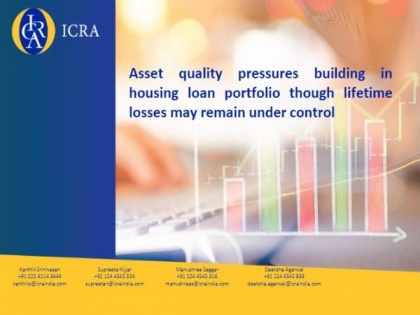Asset quality pressures building in housing loan portfolio, NPAs to worsen: ICRA
By ANI | Published: June 26, 2020 05:46 PM2020-06-26T17:46:30+5:302020-06-26T18:21:05+5:30
Nearly 30 per cent of housing finance companies (HFCs) portfolio is under moratorium and their gross non-performing assets (GNPAs) are likely to increase to 2.5 to 3 per cent in FY21, rating agency ICRA said on Friday.

Asset quality pressures building in housing loan portfolio, NPAs to worsen: ICRA
Nearly 30 per cent of housing finance compes (HFCs) portfolio is under moratorium and their gross non-performing assets (GNPAs) are likely to increase to 2.5 to 3 per cent in FY21, rating agency ICRA said on Friday.
As on March 31, the GNPAs were estimated at 1.7 per cent in housing segment while those in non-housing segment could be higher, leading to overall GNPAs of 3 to 4.5 per cent in FY21 from estimated 2.5 per cent as on March 31.
"While home loans are expected to show higher resilience on the asset quality front vis-a-vis other asset classes owing to their secured nature, the loss of income for borrowers could lead to an increase in the GNPAs percentage in the housing loan segment as well," said ICRA.
Besides, the liquidity of repossessed properties could get impacted and lead to an increase in the ultimate losses, especially those that were recently originated and financed at higher loan-to-value (LTV) ratios in case of a correction in the property prices.
The share of the self-employed segment in the housing loan book of HFCs increased over the years to 32 per cent as on December 31, 2019 from 25 per cent as on March 31, 2016.
ICRA said the self-employed segment was more impacted during stress events in the past with the GNPA percentage in this segment being almost three times of the salaried segment as on December-end.
For portfolio availing moratorium, the LTVs could increase by 6 to 10 per cent for recently originated loans extended at higher interest rates ranging between 14 and 18 per cent.
The impact on borrowers where the fixed obligation to income ratio (FOIR) was higher than 50 per cent could be more. Even at stable income levels, FOIRs could increase by 20 to 30 per cent for loans of recent vintage extended at higher interest rates ranging between 14 and 18 per cent.
"The ultimate credit losses for the HFCs could be an interplay of factors like the time period for of revival of the borrowers' income levels, borrowers' emotional attachment to the property and whether the properties are self-occupied or under construction," said ICRA.
( With inputs from ANI )
Open in app